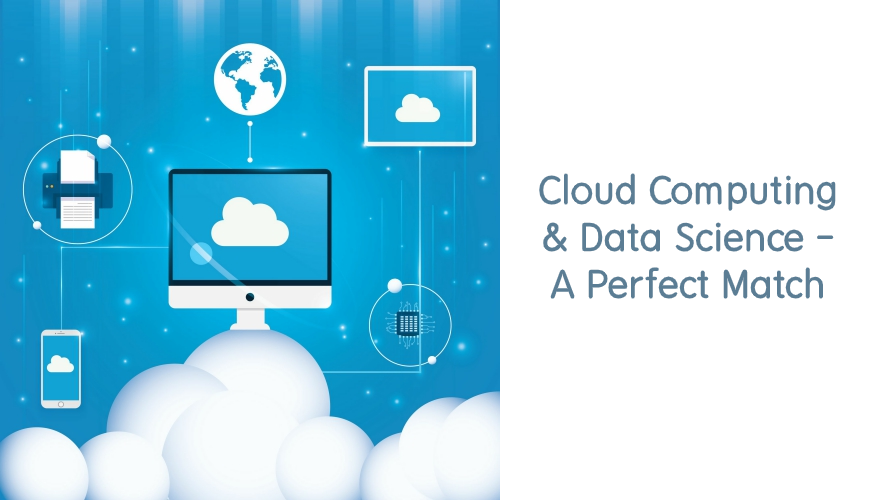Your boss calls you into her office and describes a business problem for you to solve. After analyzing the problem, you decide that a deep learning algorithm will be the best solution to the problem. Your boss gets excited and tells you to implement that deep learning solution. There’s only one problem: you don’t have the computing power to do it.
Large companies can scale their computing power by purchasing more servers. However, companies with small budgets don’t have the same luxury. Does this mean these small companies are out-of-luck?
Not by any stretch. In this article, you’ll learn why cloud computing and data science are a great match.

Disclosure: Site owner may receive commissions from purchases made when clicking on the links on this page.
What Is Cloud Computing?
Most people have an intuitive sense for what cloud computing is, but when asked to come up with a definition, they fumble a bit. They often state that it has to do with storage in the cloud. They are right to some degree. However, many cloud providers offer so much more than just storage. Also, the type of storage offer by these providers varies.
Cloud computing gives business owners the ability to create full-scale infrastructures, platforms, and software that cloud providers manage on their behalf. The three major types of cloud computing environments are:
The delineation of parameters can make the distinction between some of the services offered murky. One provider may include one service that is part of a category while another provider will not provide that service. However, it’s generally accepted to mean the following:
Infrastructure as a Service (IaaS)
The infrastructure is the hardware and the networking components (both hardware and software). The cloud providers would also provide storage options.
Platform as a Service (PaaS)
Business owners are given access to various operating systems. PaaS can also include middleware if that is needed to support the platform. Most of the bigger name cloud providers give subscribers the ability to switch between operating systems or operate multiple choices.
Software as a Service (SaaS)
This option gives subscribers access to everything offered on the cloud. This includes both offerings for IaaS and PaaS as well as application software and data. In most cases, licensing is handled via the cloud provider for software, although that depends on the software providers.
Are You Struggling to Learn Data Science? Many People Who Sign Up for This Resource Advance Their Learning. Now It's Your Turn! Become a Data Science Maven Today!
Why the Cloud?
You may be wondering why even bother with the cloud. The reason is that, when done right, it can save you significant money for your IT operations. You can provision cloud resources in an instant and often pay for only what you use. The pricing models are more complicated than described here. However, one of the biggest benefits of moving operations into the cloud is its scalability.
Before the onset of cloud operations, businesses were stuck with guessing how much computing power they needed.

They would often overestimate to ensure that they can handle any increases. However, this is wasteful, as most estimates are off the mark.
With cloud computing, you simply provision your resources as you need them, usually within minutes. You can start out small and as you grow, you add more features. Need more memory? No problem. Just ask for it. Need a database or a resize of your database? That is no trouble, either.
Why This Matters for Data Science?
Data science requires resources. The demand for these resources are often beyond the financial means of SMBs. Cloud solutions fill the gap and gives SMBs a level playing field. If you don’t have the resources to store and manage big data assets, the cloud can give you that ability.
Many cloud providers are including machine learning algorithms as part of their offerings. But even more important, they provide a pipeline for machine learning, which is often many firms don’t realize until they start implementing their ML solutions. Pipelines are almost as important as the algorithms in ML.
If you are planning on implementing deep learning algorithms, you’ll need significant processing power and, in many cases, robust storage solutions. Neural networks do best when presented with massive amounts of data. They need significant processing power to handle the hidden layers that get created as part of the algorithm.
Start Out Small
Another advantage to cloud computing is that companies can start out small and grow quickly. Scaling is often a matter of changing a setting in the configuration. In many cases, the settings can be set to scale automatically.
Are There Any Downsides to the Cloud?
No solution is perfect and cloud solutions are not right for everyone. Perhaps one of the biggest drawbacks is they are complicated. Subscribers should learn the pricing schemes to keep costs down. Some resources seem cheap, but subscribers are often hit with charges they did not know were billable. For instance, throughput for many components in a cloud system may be charged.
The complicated aspects of the cloud make it difficult for business owners to know how to implement the right solution. Most business owners are not technologically-savvy and don’t have access to an IT staff.

For this reason, it often pays to have an architect familiar with the cloud technology platforms you are considering. They will cost money, but quality architects will end up saving you money by creating a plan that fits your needs, now and in the future.
When you choose an architect who is an expert with the cloud provider you are considering, part of his or her job is to know the costs. Some components can’t be measured in terms of cost, because they charge by use. However, architects should still know about the base pricing, or at least where to look to find it (prices do change).
Some costs will be subtle. For instance, if you are charge for usage of processing time, it may be worthwhile to pay more upfront for a faster machine. It will cost more per unit of time, but will take significantly less time to complete its work than a base machine that is cheaper.
How Knowledgeable Should Data Scientists Be About Cloud Technologies?

It’s not imperative that you become a cloud architect to use cloud computing for data science. However, the more you know about how it works, the more resources you’ll have when asked how to do something by your client or manager.
For instance, if your manager needs you to find a machine learning solution but knows the company doesn’t have the computing resources, knowing about cloud providers helps you answer the call of duty, so to speak.
Conclusion
Cloud technologies offer tremendous benefits to data science teams. It does take planning and learning about how everything works. But once you do, you will have a vast new set of resources at your disposal for your data science work.
Need a Boost to Your Efforts in Learning Data Science? You Owe It To Yourself To Learn the Techniques the Right Way. You Can Learn these Methods by Trying Out a Few of These Courses.

